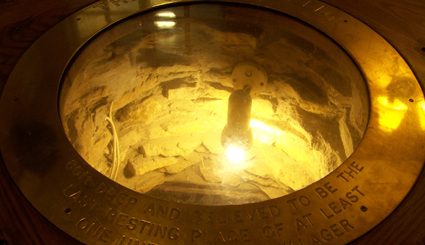Liverpool Street Underground Railway Station
Receiving roughly 123 million visitors per annum, Liverpool Street Station is considered to be the third busiest station in the United Kingdom. It is built on the site once occupied by the original Bethlem Royal Hospital (Bedlam) and is reputedly haunted by an ex-patient of the infamous asylum.
The sisters of the Order of the Star of Bethlehem were based in the Priory of St Mary Bethlehem in Bishopgate as early as 1247, when it was founded by Simon Fitz Mary, Sheriff of Bishopgate on land near the church of St. Botolph without Bishopgate. It became a hospital in 1337 and eventually became dedicated to the care of the mentally ill.
![Sunil060902 [GFDL (http://www.gnu.org/copyleft/fdl.html) or CC-BY-SA-3.0 (http://creativecommons.org/licenses/by-sa/3.0/)], from Wikimedia Commons](http://www.mysteriousbritain.co.uk/wp/wp-content/uploads/2018/11/800px-Liverpool_Street_Underground_concourse_entr-300x225.jpg) A visitation was made in March 1403 by two of the Kings Clerks. By this time Bethlem was caring for the insane, but not exclusively and it was caring for six lunatics and three sick patients. The patients themselves or their families contributed varying amounts of money for the care received. The report mentioned the use of manacles, locked chains and stocks.
A visitation was made in March 1403 by two of the Kings Clerks. By this time Bethlem was caring for the insane, but not exclusively and it was caring for six lunatics and three sick patients. The patients themselves or their families contributed varying amounts of money for the care received. The report mentioned the use of manacles, locked chains and stocks.
According to Peter Cunningham’s , Hand-Book of London (1850) ‘Henry VIII at the Dissolution gave it to the City of London, when it was first converted into an hospital for lunatics…..Simon Fitz-Mary’s Hospital was taken down in 1675, and the Hospital removed to Moorfields, “at the cost of nigh 17,000l.” The hospital was again moved in 1814 to its current location at St. George’s Fields.
’In 1598, the house was reported so loathsome and so filthily kept, as not fit to be entered; and the inmates were termed prisoners. In a record of 1619 are expenses of straw and fetters.’ (John Timbs, Curiosities of London, 1867). The 1598 inspection also found that the cesspit needed emptying and drains replacing. Violent patients would be chained to the walls and whipped or dunked in water when they became agitated.
Some patients were allowed of the hospital during the day, licensed to beg on the streets of London.
The Pictorial Handbook of London 1854 describes the treatment of those early patients. ‘The miserable creatures committed to its brutal rulers appears to have been characterised by utter indifference to the feelings and comforts of the patients, and a studied aggravation of their miseries. Indeed, to our shame be it recorded, these miseries were made the materials for actual profit to the hospital; a sum of about 400l. being annually collected by exhibiting the poor maniacs, chiefly naked, and uniformly chained to the walls of their dungeons, and by exciting them to the most violent manifestations of their maladies. This practice of showing the patients, like wild beasts, was abolished in 1770, but the abolition was unaccompanied by any other improvement in their treatment.’
Liverpool Street Underground Station was opened on 2 February 1874. In May 1917, during World War I it was hit by German bombs killing 162 people.
The Ghosts
During Summer 2000 a Line Controller noticed a something strange on the CCTV camera he was monitoring of Liverpool Street Station. At 2.00 am, in the entrance of the Central Line’s eastbound tunnel he saw a man wearing white overalls. No contractors were supposed to be working and the station was supposed to be closed, so he alerted the Station Supervisor who went to investigate. Finding nothing, the Supervisor reported back to the Line Controller via telephone. The CCTV camera showed that the figure had been standing beside the Station Supervisor and he still had not seen the figure. The Supervisor conducted a second search. The CCTV apparently showed him passing very close to the figure in white, but he still did not see him. The pair eventually gave up the search. It was then, whilst returning to the tunnel that the Supervisor found a pair of white overalls lying on a bench and there was apparently no way in which they could have been left by someone unnoticed.
The Paranormal Database refers to another related haunting dating from between 1780 and 1812, which would make it before the station was built. This relates phantom screams being heard in the area. These screams are attributed to a patient from the Bethlem Hospital named Rebecca Griffiths who according to tradition was buried without a coin that she constantly used to hold onto.




Recent Comments